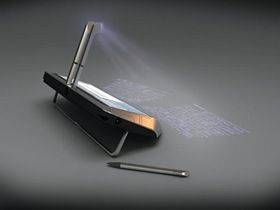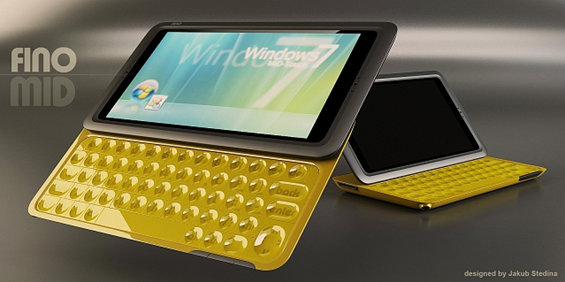As much as I hate seeing concepts that we don’t yet have the technology to create, I manage to remind myself that the market needs goals to shoot for, otherwise there won’t be innovation. That, and it is an excuse to look at some really cool looking gadgets… even if you have to pretend that they exist.
Jkk has highlighted some interesting MID concepts from an Intel sponsored design contest in the Czech Republic this year.
I really like this concept. Actually this one could potentially be produced. See the projected keyboard? Technology like that exists and can be bought today. Infrared projection keyboards have been on the market for a few years, but have had very limited adoption because of their many pitfalls, such as low visibility in highly lit settings, and no tactile feedback for key-presses. I suppose this device looks pretty cool, but its practicality would be limited to the software that powers it. If the interface could be designed so that all functions can be reached through the use of the touch screen, then it could be viable. It wouldn’t make sense to allow the only text input to come from the projected keyboard; what would the point of a mobile device be if you had to sit it down somewhere to use it? An on-screen-keyboard would suffice for short text entries (URLs/IMing, etcetera), then you could fold up the keyboard projection armatures for some serious writing. I think they would need to increase the typing experience on the projected keyboard before bringing something like this to market.
This next one is basically a smaller and slimmer HTC Shift [Portal page]. If the hardware evolves enough that we can see a sleek design like this with decent performance and battery life, I think it will make a great MID. The form factor really has a lot going for it, but the problem is finding the right size for the keyboard. Some people felt that the HTC Shift’s keyboard was right between touch-typeable and thumb-board size, and that is a major problem. As for the Windows 7 image on the screen of the rendered MID… I think it would make more sense to use a custom OS.
The main thing I want to see in upcoming mobile tech is the use of capacitive touchscreens. The iPhone and iPod Touch line have the most consistent touch recognition of any touchscreen I’ve ever used, and in general have a lot of advantages over the current standard that is resistive touchscreen technology. I have always hated having to use a stylus to navigate the GUI of a device because they made the interface based on old principles. I feel that in the future we will start to move away from styli on mobile devices (they will certainly stick around for tablet PC folks, and graphic artists), and that is a change that I welcome with open arms.













I could never understand why anyone would think it’s a good idea to poke tiny buttons with a tiny stylus on a small touch-screen device. In fact, if you have a tablet pc with a high-res screen, it can be difficult to hit small buttons (e.g. firefox’s close tab button), navigate menus, and hit links on websites quickly and confidently with the stylus. I can’t even imagine how annoying it would be to use a tiny stylus. UI designers need to remember that it’s a TOUCH-screen device, and should be designed for our fat fingers.
I totally agree upon that. A stylus is a thing of the past – we have fingers and should be able to use them. I used to be a big fan of palm and the need for a stylus there always brought me down. Looking for a adequate successor of my beloved TX though…
Nomax
Stylus input it definitely a thing of the past. But they will continue to exist (e.g. Nokia N97) because the massive Asian market needs it to input text (i.e. draw their symbols).
Resistive screens will disappear the second someone out there develops an “electric” Stylus that is able to stimulate a capacitive screen.
I actually like using styli because I take written notes in my classes. A touch screen makes a terrible keyboard, and a keyboard doesn’t give me the same freedom that a sheet of paper does. Styli aren’t going anywhere until a noninvasive way to direly link a computer to your brain is developed.